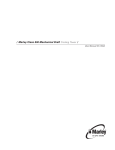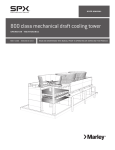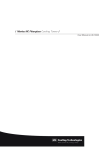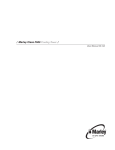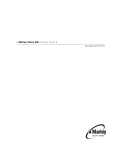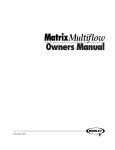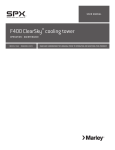Download SPX Cooling Technologies MARLEY CLASS 800 User's Manual
Transcript
/ Marley Class 800 Mechanical Draft Cooling Tower / User Manual 95-1356A }Ê/iV }ià >ViÊNÊ>ÊÀÞÊ }ÊNÊ>ÀiÞ Notice The following defined terms are used throughout this manual to bring attention to the presence of hazards of various risk levels, or to important information concerning the life of the product. Warning Indicates presence of a hazard which can cause severe personal injury, death or substantial property damage if ignored. ▲ Caution Indicates presence of a hazard which will or can cause personal injury or property damage if ignored. ▲ Note Indicates special instructions on installation, operation or maintenance which are important but not related to personal injury hazards. These instructions assist in obtaining efficient, long life from Marley cooling equipment. Direct questions concerning cooling tower operation and maintenance to your Marley sales office or representative. Always include your tower serial number when writing for information or ordering parts. Look for this number on the nameplate near the access. Contents General.................................................................................................... 4 Before Start-up........................................................................................ 5 Initial Starting Procedure......................................................................... 7 Routine Starting Procedure..................................................................... 8 Operation................................................................................................. 9 Freezing Weather Operation.................................................................. 11 Temperature Control and Energy Management.................................... 13 Maintenance.......................................................................................... 15 Cleaning................................................................................................ 17 Water Treatment.................................................................................... 18 Seasonal Shutdown Instructions........................................................... 20 Spare Parts and Accessories................................................................ 21 Troubleshooting..................................................................................... 22 Safety.................................................................................................... 24 Inspection and Maintenance Schedule................................................. 25 Inspection Checklist.............................................................................. 26 General A cooling tower, like any heat exchanger, exchanges all heat imposed upon it from one fluid to another fluid. For a cooling tower, heat from the water is put into the air. The plant process replenishes the heat to the water, typically at another heat exchanger such as a condenser. A cooling tower differs from many heat exchangers in that heat is transferred in two forms—sensible and latent heat. As heat is transferred from the water, the air temperature increases (sensible) and the air’s water content, or humidity, also increases (latent). As the heat load, inlet air wet-bulb temperature, or airflow on a cooling tower changes, the cooling tower will respond by finding a new equilibrium with the process. The cooling tower will still dissipate all the heat from the process, but at new water temperatures. The cooling tower cold water temperature is the supply water temperature to the condenser, and changes in the cold water temperature usually affect efficiency of the plant output. Although the reduced cold water temperatures that result from maximum fan power utilization are usually beneficial to plant output, the amount of fan power affects the cost of running the cooling tower. As these variables interact on a cooling tower, the operator must find the proper trade-off between these opposing forces. These instructions will assist in obtaining efficient, long life from Marley cooling equipment. Direct questions concerning tower operation and maintenance to your Marley sales office or representative. Always include your tower serial number when writing for information or ordering parts. Look for this number on the nameplate near the tower access. Before Start-up Safety ▲ Caution Temporary safety barricades should be placed around any exposed openings in the operating (or nonoperating) tower, safety harnesses should be worn by personnel where appropriate, and other safety precautions should be taken in compliance with OSHA regulations and standards. Cleaning Clean any nozzles that are clogged. Remove any sediment from the cold water basin, sump and screens. Use a water hose to flush cold water basins. If you are restarting or recommissioning a previously used tower, see Warning note on page 17. Inspection It is imperative that all operating assemblies be inspected before they are placed in operation. The following is a list of components to be checked before starting the tower: •Check drive shaft alignment. Realign if necessary. See Marley Drive Shaft Service Manual. •Check tightness of bolts that attach mechanical equipment support to the tower structure. Check tightness of bolts in fan cylinder joints and fan cylinder anchorage. •Check concrete structural surfaces for spalling and cracks. Repair as necessary. •Check tightness of the following bolted joints in the fan and drive assemblies: –Fan hub clamp bolts. See Marley Fan Service Manual for correct torque setting. –Fan hub cover bolts, where applicable. ® –Geareducer and motor mounting bolts. –Drive shaft coupling and guard bolts. •Check Geareducer oil for sludge or water by draining off and testing a sample as outlined in the Marley Geareducer Service Manual. Check Geareducer oil level at “oil level” mark on the side of the case. Add oil as required. The oil level placard must be adjusted so that its “full” mark is at the same elevation as the “full” mark on the side of the Geareducer case. Check oil lines to be sure there are no leaks and all joints are tight. ➠ Before Start-up See Geareducer Service Manual for oil filling procedure and list of recommended lubricants. •Rotate fan by hand to be sure of free rotation and ample tip clearance. See Marley Fan Service Manual. •Check motor insulation with a “Megger.” See maintenance section of Marley Electric Motor Service Manual. •Lubricate the motor according to motor manufacturer’s instructions. •Test run each fan separately for a short time. Check for excessive vibration or unusual noise. If either is present, see Troubleshooting on pages 22 and 23 of this manual. Fan must rotate clockwise when viewed from above. Recheck Geareducer oil level. •Check functioning of make-up water supply. •Make sure the blowdown or bleed-off will carry the proper amount of water. (See Blowdown on page 18.) Operate Water System Complete steps 1 thru 4 under Initial Starting Procedure on page 7. Circulate water over the tower continuously for several days before starting the mechanical equipment and putting the tower into continuous operation. ▲ Caution Do not circulate water over the tower in freezing weather without a heat load. (See Caution note on page 8.) Initial Starting Procedure 1—Fill the cold water basin and circulating water system to a level 1/2” (13 mm) below the overflow. 2—Bypass valve should be closed unless start-up is in cold weather. (See Routine Starting Procedure on page 8.) 3—Prime and start the circulating water pumps one at a time. Increase the flow of circulating water gradually to design water rate to avoid surges or water hammer which could damage the distribution piping. 4—When flow has stabilized at or near the design rate, adjust water make-up to maintain the level that the water has pumped down to in the cold water basin. (See Cold Water Collection Basin on page 10.) This should coincide reasonably with the recommended operating water level indicated on the Marley project drawings. 5—Start the fan(s). After 30 minutes operating time, to permit Geareducer oil to come up to operating temperature, check motor load with watt meter, or take operating volt and ampere readings and calculate motor horsepower. Refer to Marley Fan Service Manual for instructions. ▲ Caution If it is necessary to adjust fan pitch to pull correct contract horsepower, measure results when circulating design water rate at design hot water temperature. Horsepower will change with air density. Lock out all electrical service before entering fan area. Routine Starting Procedure After periods of routine shutdown, the following restarting procedure should be followed: •Start the circulating water pump(s). Increase the flow of circulating water gradually to design water rate to avoid surges or water hammer which could damage the distribution piping. ▲ Caution Circulating cold water over a tower in freezing weather will cause ice to form, which may cause damage to the fill system. Water should be bypassed directly to the cold water basin until the heat load causes its temperature to rise above 70°F (21°C), at which time it may be directed over the tower. Also, towers must not be operated with reduced water rate and/or no heat load during freezing weather. If a bypass is used, do not modulate. •Start the fan(s). On multi-cell towers, only as many fans should be started as are needed to produce the desired cold water temperature. If the tower is equipped with two-speed motors, fans may be progressively started at half speed, increasing to full speed as necessary to maintain the desired cold water temperature. (See Temperature Control and Energy Management on pages 13 and 14.) Operation Tower Performance The following is intended to serve as a guideline for the operation of this counterflow mechanical draft cooling tower. The owner may use this information to develop preliminary operating procedures. As operational experience with the system accumulates, more definitive responses to specific conditions will be developed by the owner’s operating personnel. Keep the tower clean and the water distribution uniform to obtain continued maximum cooling capacity. (See Caution note on page 15 and Warning note on page 17.) Do not allow excessive deposits of scale or algae to build up on the filling or eliminators. Keep the nozzles free of debris to assure correct distribution and cooling of water. Uniform water distribution over the entire fill plan area is vital to the efficient operation of a film-filled cooling tower. The capacity of a tower to cool water to a given cold water temperature varies with the wet-bulb temperature and the heat load on the tower. As the wet-bulb temperature drops, the cold water temperature also drops. However, the cold water temperature does not drop as much as the wetbulb temperature. (Wet-bulb temperature is the temperature indicated by the wet-bulb thermometer of a sling or mechanically aspirated psychrometer.) A tower does not control the heat load. For a given heat load, the quantity of water circulated determines the cooling range. The hot and cold water temperatures increase with higher heat loads. (Cooling range is the temperature difference between the hot water coming into the cooling tower and the cold water leaving the tower.) Fan Drive Air is caused to move through the tower by the operation of electric motordriven fans. At full speed, these fans are designed (and pitched) to move the amount of air required to accomplish the design thermal performance. Proper utilization of these fans provides the operator a means by which to adjust the level of thermal performance to suit the requirements of the load. (See Temperature Control and Energy Management on pages 13 and 14.) ▲ Caution If two-speed motors are used, allow a time delay of a minimum of 20 seconds after de-energizing the high speed winding and before energizing the low speed winding. Tremendous stresses are placed on driven machinery and motor unless the motor is allowed to slow to low speed rpm or less before the low speed winding is energized. ➠ Operation When changing fan direction of rotation, allow a minimum of two minutes time delay before energizing the fan motor. Hot Water Distribution System Hot water from the process flows through an inlet to each cell, which supplies a distribution header and a system of branch arms and nozzles. Each distribution header may be equipped with a vent standpipe to minimize water hammer, to maintain a slightly pressurized water distribution system, and to provide vacuum release at pump shutdown. ▲ Caution If an Amertap condenser tube cleaning system is part of plant equipment, care should be taken during operation to back-wash the strainer section only after the sponge rubber cleaning balls are removed from the system by trapping them in the collector. Balls that are allowed to enter the cooling tower supply piping may clog some of the nozzles, although the generous flow paths through the nozzles make this unlikely. However, balls escaping the nozzles will accumulate on top of the fill, ultimately causing unequal water distribution that will affect thermal performance. The top of the fill should be frequently checked until such time as the operational sequence of the Amertap system assures that no balls enter the cooling tower distribution system. Fill Water leaving the nozzles is scattered uniformly over the fill plan area. The water flows through the fill, coating each fill sheet to maximize water surface exposure to the air being moved by the fans. Drift Eliminators Air leaving the fill passes through a level of drift eliminators covering the entire plan area of the tower. The purpose of these drift eliminators is to minimize the amount of water that is caused to exit the tower by the velocity of the moving airstream. Cold Water Collection Basin Water leaving the fill falls into the cold water basin that forms the base of the tower. The normal water level in the concrete basin is approximately 12” (305 mm) below the top of the curb. Adjust the make-up water supply to maintain approximately this water level. Maintain sufficient water depth to prevent cavitation. 10 Freezing Weather Operation ▲ Note During periods of low ambient air temperatures, 35°F to 40°F (2°C to 4°C) or below, it is advisable to maintain the cold water temperature at or above 70°F (21°C) to retard the formation of ice and to assist in its control. The methods used in Minimizing Tower Energy Use, described on page 13 are those which the operator would use to maintain water temperature at or above 70°F (21°C). In combinations of low ambient air temperatures and reduced loads, fan speed manipulation may not be sufficient to maintain an acceptable water temperature. Even with fans off, the natural movement of air through the tower may be enough to continue reducing the water temperature. When that happens, it will become necessary to open the bypass valve, if so equipped, and allow total circulation to flow directly into the cold water basin until such time as the basin water inventory rises to a temperature level sufficiently high to preclude frequent changeovers from normal flow to bypass flow. That temperature level might be 85°F to 90°F (29°C to 32°C), but should be determined by operator experimentation. Deicing The formation of ice on towers operating in freezing weather cannot be completely prevented, but can be acceptably controlled. Ice will form on the relatively dry parts of the tower that are in contact with the incoming air. Primarily, this includes the columns, structural framing, and fill at the air inlets. Ice forming characteristics on any given tower will vary, depending on velocity and direction of wind, circulating water rate and heat load. The Class 800 tower is designed with few structural components in the falling water zone, which prevents damage due to falling ice. However, structural damage can still result from excessive buildup of ice attached to the fill. A regularly programmed inspection (one walk around the tower per shift) during cold weather operation is the best way to determine if ice buildup on the fill is occurring. If ice is observed and determined to be acceptable, maintain full (total) design flow over the tower. Excessive ice formation may be controlled by regulating air and water flow through the tower by one or more of the following procedures: •Shut the fan down. This reduces the cooling rate to a minimum and increases the quantity of warm water at the air inlet to a maximum. Except for extreme cold conditions or extended freezing conditions, this procedure will normally control ice formation. If the tower has two-speed motors, operate the fan at half speed forward. This also reduces the cooling rate and increases the quantity of warm water at the air inlet. ➠ 11 Freezing Weather Operation •Under extended extreme cold conditions, it may be necessary to operate the fan in reverse. This forces warm air out through the air inlets, melting any accumulated ice. Reversal may be at either full or half speed; however, full speed is recommended if adequate heat load is available. Reverse operation of the fan should be avoided, where possible, and should not exceed 15 to 20 minutes. ▲ Caution ▲ Caution Reverse operation of fans for prolonged periods during subfreezing weather can cause severe damage to fans and fan cylinders. Ice can accumulate inside fan cylinders at fan blade plane of rotation and fan blade tips will eventually strike this ring of ice, damaging the fan blades or cylinder. Ice can also accumulate on fan blades and be thrown off, damaging fan cylinder or blades. Reverse operation of fans with adjacent fans not operating increases probability of icing. The low discharge velocity of moist air from fan cylinders in which fans are not in operation can result in moisture-laden air being pulled into the adjacent cylinder in which the fan is operating in reverse, increasing this ice buildup. Therefore, fans each side of the one operating in reverse must be operated in forward rotation at full or half speed, or all fans must be operated in reverse. Allow a minimum of 10 minutes delay between reverse operation and forward operation during subfreezing weather to permit ice to dissipate from fan blades and fan cylinders. •With no heat load on the circulating water, icing cannot be controlled effectively by air control alone during freezing weather. Towers must not be operated with reduced water rate and/or no heat load during freezing weather. If a bypass directly into the cold water basin is used, all water must be bypassed. Water flow over the tower must never be modulated during freezing weather. See Fan Drive on pages 9 and 10 for fan speed change and reversing precautions. Intermittent Operation ▲ Caution 12 When the unit is operated intermittently during winter weather, it is necessary that the water be drained from the tower piping to insure protection against freezing and possible rupture. Temperature Control and Energy Management The wet-bulb temperature of the ambient air varies significantly on a daily basis, and considerably from season to season. As the wet-bulb temperature reduces, the tower becomes capable of producing colder and colder water—or it becomes capable of producing a given cold water temperature at reduced airflow through the tower. These characteristics are the “opposing forces” referred to on page 4. Maximizing Tower Performance If your operating system is one which benefits from the coldest possible water; that is, if colder water allows you to increase your output—or allows you to operate your system at significantly lower cost, then continuous full speed operation of the fan(s) may be your best mode of operation. ▲ Note In this mode of operation, concern for the cold water temperature level would be limited to the potential for the tower to form ice during freezing weather. (See Caution note on page 8 and Freezing Weather Operation on pages 11 and 12.) Although the 70°F (21°C) cold water temperature indicated on page 11 is appropriate for cold weather start-up and operation, acceptable temperatures during full operation in spring, summer, and fall may be appreciably lower, perhaps as low as 50°F (10°C) or less. Refer to your performance curves for expected tower cold water temperatures at varying flow rates, ranges, and wet bulb temperatures. Minimizing Tower Energy Use Most systems gain no operating or production benefits from water temperatures below a certain level, and that level is not usually below the aforementioned 70°F (21°C). When a reducing ambient wet-bulb permits the tower to reach that target cold water temperature level, further reductions in the wet-bulb temperature permit manipulation of fan speeds or operation to maintain that temperature level. Single-speed fans can be cycled on and off for cold water temperature control, with the steps of control depending upon the number of fan cells in the tower. Two-speed motors offer twice as many control steps—with the added bonus that half-speed (which produces half of the normal airflow through the tower) requires less than 20% of the full-speed power requirement. ▲ Caution Excessive cycling of motors causes overheating of the windings and ultimate failure of the motor. The total amount of starting time (period of high inrush current) should not exceed 30 seconds per hour. On fans 20 feet diameter and smaller, this may allow 4 or 5 starts per hour. On larger fans, 1 or 2 starts per hour may be the limit. Determine the ➠ 13 Temperature Control and Energy Management number of seconds it takes your fan to get to full-speed (by observation) and divide that number into 30 to obtain the recommended maximum number of starts per hour. Two-speed motors cycling between half and full speeds permit a commensurately greater number of control cycles. Variable frequency drives, of course, provide the ultimate in both temperature control and energy management and can be easily retrofitted to your system. Please discuss this with your Marley representative. 14 Maintenance Well maintained equipment gives the best operating results and the least maintenance cost. A regular inspection schedule is recommended to insure effective safe operation of the cooling tower. Use the Inspection and Maintenance Schedule on page 25 to obtain continuously good performance with least tower maintenance. See the Inspection Checklist on pages 26 and 27 in this manual. Keep a continuous lubrication and maintenance record for each cooling tower. Conduct regular inspections, repair personnel safety items (items 20 and 21 in the table on page 25) and maintain records of all—this is especially important. For a supply of check list forms, contact your Marley sales office or representative. Hot Water Distribution System Keep the circulating water and distribution system (piping and nozzles) clean and free of dirt, algae, and scale. Algae and scale may clog nozzles, eliminators, fill, and piping, and may collect on the equipment served thus reducing its performance ▲ Note See Caution note below under Fill. Access The optional access door in the fan deck with an optional short ladder to the top of the fill provides a means for inspection of the plenum area above and below the eliminators. ▲ Caution Removal of eliminator packs allows access to the spray chamber for inspection and maintenance of the nozzles and top of fill. Under no circumstances are the eliminators to be used as a walking surface. Provide top surface protection before walking on the fill. Fill ▲ Caution Clean, free-flowing, unobstructed fill is key to the continued efficient operation and performance of a cooling tower. The owner/operator must keep the circulating water clean by treatment, screening, or filtering to avoid the possibility of fill clogging. Sea water, if used, will typically present increased clogging problems due to suspended solids and/or biological growth if the water is not properly filtered and treated. The dissolved ions do not present unusual clogging problems. Contributors to the clogging of fill are trash and debris, algae, slime, and scale—with the effects of scale often being worsened by the presence of suspended muds. All of these can be controlled with some combination of water treatment, screening, and filtration, and it is the owner’s respon- ➠ 15 Maintenance sibility to institute a program of water treatment and maintenance that will minimize their impact. (See Water Treatment on pages 18 and 19.) Tower Framework Inspect for cracks and spalling and repair if necessary. Keep bolts tight in the mechanical equipment supports. Maintain a positive Langelier index in your circulating water. (See Water Treatment on pages 18 and 19.) Drive Shaft Check drive shaft alignment and condition of couplings every six months. See the Drive Shaft Service Manual for correcting misalignment, balancing, or replacing parts. Electric Motor Lubricate and maintain each electric motor in accordance with the manufacturer’s instructions. If repair work is necessary, contact the nearest representative of the motor manufacturer. See Warranty Section of Marley Service Manual on Electric Motors. Fan Inspect fan blade surfaces every six months. For detailed maintenance information, refer to Marley Fan Service Manual. Geareducer Make weekly and monthly oil checks. Inspect internal parts during seasonal oil change. Refer to the Geareducer Service Manual for detailed maintenance instructions. Cold Water Collection Basin Inspect collection basin occasionally for cracks, leaks, and spalling and repair if necessary. Maintain a positive Langelier index in your circulating water. (See Water Treatment on pages 18 and 19.) Keep cold water outlets clean and free of debris. Make-up and circulating water controls must operate freely and maintain the desired water quantity in the system. 16 Cleaning Warning Any evaporative-type cooling tower must be thoroughly cleaned on a regular basis to minimize the growth of bacteria, including Legionella Pneumophilla, to avoid the risk of sickness or death. Service personnel must wear proper personal protective equipment. Do NOT attempt any service unless the fan motor is locked out. Operators of evaporative cooling equipment, such as water cooling towers, should follow maintenance programs which will reduce to an absolute minimum the opportunity for bacteriological contamination. Public health service officials have recommended that “good housekeeping” procedures be followed, such as: regular inspections for concentrations of dirt, scale, and algae; periodic flushing and cleaning; and the following of a complete water treatment program including biocidal treatment. Visual inspection should take place at least once a week during the operating season. Periodic flushing and cleaning should be done at least twice a year. Nozzles, louvers, drift eliminators, and easily accessible fill surfaces should be flushed by use of a moderate-pressure water nozzle, being careful not to cause physical damage. A reliable water treatment program should be installed and maintained. 17 Water Treatment Blowdown Blowdown, or bleed-off is the continuous removal of a portion of the water from the circulating system. It is used to prevent dissolved solids from concentrating to the point where they will form scale. The amount of blowdown required depends upon the cooling range (design hot water temperature minus design cold water temperature) and the composition of the make-up water (water added to the system to compensate for losses by blowdown, evaporation, and drift). The following table shows the amount of blowdown (percent of total water flow) required to maintain different concentrations with various cooling ranges: Cooling Range 1.5X 2.0X Number of Concentrations 2.5X 3.0X 4.0X 10°F ( 5.56°C) 1.58 0.78 0.51 0.38 0.25 15°F ( 8.33°C) 2.38 1.18 0.78 0.58 0.38 20°F (11.11°C) 3.18 1.58 1.05 0.78 0.51 25°F (13.89°C) 3.98 1.98 1.32 0.98 0.64 30°F (16.67°C) 4.78 2.38 1.58 1.18 0.78 Multipliers are based on drift of 0.02% of the circulating water rate. 5.0X 0.18 0.28 0.38 0.48 0.58 6.0X 0.14 0.22 0.30 0.38 0.46 Example: 150,000 gpm (9465 L/s) circulating rate, 28°F (15.56°C) cooling range. To maintain 3 concentrations, the required blowdown is 1.1% or .011 times 150,000 gpm (9465 L/s) which is 1650 gpm (104.1L/s). If tower is operated at 3 concentrations, circulating water will contain three times as much dissolved solid as the make-up water, assuming none of the solids form scale or are otherwise removed from the system. ▲ Note The use of corrosion and scale inhibitors is strongly recommended. Chemical Treatment In some cases chemical treatment of the circulating water is not required if adequate blowdown is maintained. In most cases, however, chemical treatment is required to prevent scale formation and corrosion. Sulfuric acid or one of the polyphosphates is most generally used to control calcium carbonate scale. Various proprietary materials containing phosphates or other compounds are available for corrosion control. When water treatment chemicals are required, the services of reliable water treating companies should be obtained. ▲ Note The circulating water pH should be maintained between 7.0 and 8.5. The Langelier index (calcium carbonate saturation index) has proven to be an effective tool in predicting the aggressiveness of cooling tower water toward concrete. The Langelier index relates the methyl orange alkalinity, the calcium hardness, the total solids, the pH value, and the temperature of the water. From these values it is possible to calculate the index and 18 Water Treatment predict the corrosive tendencies of the tower water toward concrete. An explanation and method of calculating the Langelier index can be found in all books on water treatment. Maintaining a positive Langelier index provides excellent protection of concrete. Slime, a gelatinous organic growth, and algae, a green or brown plant growth, may grow in the cooling tower or heat exchangers. Their presence can interfere with cooling efficiencies. Proprietary compounds are available from water treating companies for the control of slime and/or algae; however, compounds which contain copper are not recommended. ▲ Caution Chlorine, if used, should be introduced at a point in the circulating water system that will promote rapid dispersal, and residual chlorine should not exceed one part per million parts water (1 ppm). Scaling Scale can be caused by the uncontrolled presence of sulfates, silicates, carbonates, or oxides, and their effect can be accentuated by the presence of suspended muds. Some suggestions and limitations follow: •Calcium sulfate may be introduced in the make-up water stream and/or produced by the use of sulfuric acid for pH adjustment. The concentration of calcium sulfate should be kept below 1000 ppm, expressed as CaCO . 3 •Calcium carbonate generally will not form scale in the cooling tower if carbonate scaling does not occur in the condenser. However, if make-up water contains surplus free carbon dioxide, scaling may be inhibited in the condenser but may occur in the fill because of CO stripping. 2 •Silica scale is virtually impossible to remove. However, silica scale is unlikely if concentrations of SiO are held below 150 ppm. 2 •Oxides, such as iron oxide, can coat all parts of the system if soluble iron is present in concentrations above 0.5 ppm. Iron oxides do not usually develop into thick scales but, like mud, can accentuate the development of other scales. Foaming Heavy foaming sometimes occurs when a new tower is put into operation. This type of foaming generally subsides after a relatively short period of operation. Persistent foaming can be caused by the concentrations of certain combinations of dissolved solids or by contamination of the circulating water with foam-causing compounds. This type of foaming can sometimes be minimized by increasing the blowdown, but in some cases foam depressant chemicals must be added to the system. Foam depressants are available from a number of chemical companies. 19 Seasonal Shutdown Instructions Tower Drain all tower piping. During shutdown, clean the tower and make any necessary repairs. Apply protective coating as required to all metal parts. Particular attention should be given to mechanical equipment supports, drive shaft and drive shaft guards, Geareducers, and motors. See Warning note on page 17 regarding tower cleaning. Visually inspect for concrete deterioration. If ambient temperature is 32°F (0°C) or below, do not put cold water on tower. Mechanical Equipment Shutdown for less than 3 months. Each month, drain water condensate from the lowest point of the Geareducer and its oil system. Check oil level and add oil if necessary. Operate Geareducer briefly to recoat all interior surfaces with oil. At start-up, drain water condensate and check oil level. Add oil if necessary. Refer to Geareducer Service Manual for maintenance and lubrication instructions. Shutdown for 3 months or longer. If the motors have space heaters, operate mechanical equipment one hour each month. Space heaters should be energized anytime motor is not operating. If the motors do not have space heaters, operate mechanical equipment one hour each week. At start-up, operate mechanical equipment one hour or until oil is warm, then shut the equipment down. Drain the oil and refill with new oil. Refer to Geareducer Manual for instruction on changing oil. Refer to Marley Downtime Instruction Manual for downtime of 6 months or longer. Electric Motors ▲ Caution Do not start motor without determining that there will be no interference with free rotation of the fan drive. Refer to Marley Electric Motor Service Manual. If shutdown period is longer than seasonal, contact your Marley sales office or representative for additional information. 20 Spare Parts and Accessories Spare Parts SPX Cooling Technologies manufactures and maintains a stock of replacement parts for all cooling tower mechanical equipment. Shipment of these parts is normally made within ten days after an order is received. If emergency service is necessary, contact the local Marley sales office or representative for assistance. To prevent prolonged shutdown periods in case of damage to the mechanical equipment, it is suggested that the following parts be carried in the owner’s stock: •One fan assembly •One Geareducer assembly •One drive shaft assembly •One electric motor • Six branch arms • Six seal rings • 100 ft. roll of Band-it •One box of Band-it buckles Be sure to furnish the tower serial number when ordering parts. Accessories Marley accessories are designed for improved maintenance access, safety, component handling, and the general customization of the tower to suit your process. These accessories include stairways, walkways (external and internal), mechanical equipment removal systems, derricks, and davits, as well as variable frequency drives (page 14) and other retrofittable control devices. Please discuss your needs with your Marley representative. 21 Troubleshooting Trouble Cause Remedy Motor Will Not Start Power not available at motor terminals 1. Check power at starter. Correct any bad connections between the control apparatus and the motor. 2. Check starter contacts and control circuit. Reset overloads, close contacts, reset tripped switches, or replace failed control switches. 3. If power is not on all leads at starter make sure overload and short circuit devices are in proper condition. Check motor and control connections against wiring diagrams. Check nameplate voltage against power supply. Check voltage at motor terminals. Check stator windings for open circuits. Disconnect motor from load and check motor and Geareducer for cause of problem. Look for broken bars or rings. Stop motor and attempt to start it. Motor will not start if singlephased. Check wiring, controls, and motor. Check motor connections against wiring diagram on motor. Check lubrication. Replace bad bearings. Check voltages and currents of all three lines. Correct if required. Check and correct bracket fits or bearing. Rebalance. Reinstall or replace fan. Check voltage and current of all three lines against nameplate values. Check fan blade pitch. See Fan Service Manual. Check for drag in fan drive train as from damaged bearings. Check nameplate against power supply. Check RPM of motor and gear ratio. Remove grease reliefs. Run motor up to speed to purge excessive grease. If not poor machining, replace worn bearing. Change to proper lubricant. See motor manufacturer’s instructions. Stop motor and attempt to start it. Motor will not start if singlephased. Check wiring, controls, and motor. Clean motor and check ventilation openings. Allow ample ventilation around motor. Check with Ohmmeter Straighten or replace shaft. Remove plugs and re-grease bearings. Flush bearings and relubricate. Wrong connections Low voltage Open circuit in motor winding Motor or fan drive stuck Unusual Motor Noise Rotor defective Motor running single-phase Motor leads connected incorrectly Ball bearings Electrical unbalance Motor Runs Hot Air gap not uniform Rotor unbalance Cooling fan hitting guard Wrong voltage or unbalanced voltage Overload Wrong motor RPM Bearings over-greased Rotor rubs stator bore Wrong lubricant in bearings One phase open Poor ventilation Winding fault Bent motor shaft Insufficient grease Deterioration of or foreign material in grease Bearings damaged Motor Does Not Come Up Incorrect fan blade pitch To Speed Voltage too low at motor terminals because of line drop Broken rotor bars 22 Replace bearings. See Fan Service Manual for blade pitching instructions. Check transformer and setting of taps. Use higher voltage on transformer terminals or reduce loads. Increase wire size or reduce inertia. Look for cracks near the rings. A new rotor may be required. Have motor service man check motor. Troubleshooting Trouble Cause Remedy Wrong Rotation (Motor) Geareducer Noise Wrong sequence of phases Geareducer bearings Switch any two of the three motor leads. If new, see if noise disappears after one week of operation. Drain, flush, and refill Geareducer. See Geareducer Service Manual. If still noisy, replace. Correct tooth engagement. Replace badly worn gears. Replace gears with imperfect tooth spacing or form. Tighten all bolts and cap screws on all mechanical equipment and supports. Make sure motor and Geareducer shafts are in proper alignment and “match marks” properly matched. Repair or replace worn couplings. Rebalance drive shaft by adding or removing weights from balancing cap screws. See Drive Shaft Service Gears Unusual Fan Drive Vibration Loose bolts and cap screws Unbalanced drive shaft or worn couplings Fan Worn Geareducer bearings Unbalanced motor Bent Geareducer shaft Fan Noise Loose fan hub cover Blade rubbing inside of fan cylinder Loose bolts in blade clamps Manual. Make certain all blades are as far from center of fan as safety devices permit. All blades must be pitched the same. See Fan Service Manual. Clean off deposit buildup on blades. Check fan and pinion shaft endplay. Replace bearings as necessary. Disconnect load and operate motor. If motor still vibrates, rebalance rotor. Check fan and pinion shaft with dial indicator. Replace if necessary. Tighten hub cover fasteners. Adjust cylinder to provide blade tip clearance. Check and tighten if necessary. 23 Safety The tower has been designed to provide a safe working environment while either operating or shut down. The ultimate responsibility for safety rests with the Operator and Owner. When flow to the tower is shut off or when portions of the tower require maintenance, temporary safety barricades may be required around openings. Other safety precautions such as safety harnesses should be utilized where appropriate for compliance with OSHA regulations and standards and good safety practices. Routine periodic maintenance must be performed on all personnel access and material handling accessories in accordance with the following schedule: Ladders, Stairways, Walkways, Handrails, Hatch Covers, Decks, and Access Doors Inspect for General Condition Inspect and Repair for Safe Use Inspect and Repair Before Each Use 24 Semi-Annually Davits, Derricks, and Hoists Semi-Annually Yearly As Required Inspection and Maintenance Schedule General Recommendations 1. Inspect for clogging 2. Check for unusual noise or vibration 3. Inspect keys, keyways, and set screws 4. Make sure vents are open D D D D W Davits, Derricks, Hoists Stairs, Ladders, Walkway, Doors, Handrails Casing and Louvers Fan Cylinder Structural Members Control Valves or Gates Suction Screen Water Make-up System Hot Water System Cold Water Basin Fill Drift Eliminators M M W S S S S 5. Lubricate (grease) S R 6. Check oil seals 7. Check operating oil level S M D 8. Check static oil level M 9. Check oil for water and sludge 10. Change oil Geareducer Drive Shaft and Guards Motor Fan More frequent inspection and maintenance may be desirable. M S 11. Check fan blade tip clearance S 13. Check for leakage 14. Inspect general condition W S S S S S S S Y S Y S Y S S S Y S S S 16. Clean R R R R R R S R R R R 18. Rebalance R R Y Y 12. Check water level 15. Tighten loose bolts 17. Repaint 19. Completely open and close 20. Inspect/repair for safe use 21. Inspect and repair before each use D D S S S S Y R S R R R R D—Daily; W—Weekly; M—Monthly; Q—Quarterly; S—Semi-annually; Y—Yearly; R—As Required S Y R 25 Inspection Checklist Date Inspected Inspected By Owner Location Owner's Tower Designation Tower Manufacturer Model No. Process Served by Tower Operation: Design Conditions GPM Cell No. Number of Fan Cells HW °F Serial No. Continuous CW Tower Type: Counterflow ❏ Intermittent ❏ °F WB Date Tower was installed Condition: 1—Good 2—Keep an eye on it 1 Structure Casing Material Structural Material Fan Deck Material Stairway ❏ Material Ladder Handrail ❏ ❏ Material Material Interior Walkway ❏ Material Cold Water Basin Material Water Distribution System Spray Type System Header Pipe Material Branch Pipe Material Nozzles—orifice diameter size in. Up spray ❏ Down spray ❏ Heat Transfer System Fill—type & material Eliminators—type & material Louvers—type & material Use this space to list specific items needing attention: 26 2 3 3—Needs immediate attention Comments Seasonal ❏ °F Inspection Checklist Condition: 1—Good Mechanical Equipment Speed Reducer Type Belt ❏ 2—Keep an eye on it Gear ❏ 3—Needs immediate attention 1 2 3 Direct Drive ❏ Comments Belt Drive Unit Belt Designation Fan Sheave Designation Motor Sheave Designation Gear Drive Unit Manufacturer Oil Level Oil Condition: Model Add Immediately ❏ Contains Water ❏ Full ❏ Good ❏ Ratio Low, check again soon ❏ Contains Metal ❏ Contains Sludge ❏ Oil Type Used Seals Backlash Fan Shaft Endplay Unusual Noises? No ❏ Yes ❏ Action Required Drive Shaft Manufacturer Material Fan Fan Type Propeller ❏ Blower ❏ Manufacturer Diameter Fixed Pitch ❏ Adjustable Pitch ❏ Number of Blades Blade Material Hub Material Hub Cover Material Blade Assembly Hardware Tip Clearance " min " max Vibration Level Fan Cylinder Mechanical EquipmentSupport Oil Fill and Drain Line Oil Level Sight Glass Vibration Limit Switch Motor Manufacturer Name Plate Data F L Amps HP RPM Frame SF Phase Hz Special Info. Volts Last Lubrication—Date Grease Used—Type Unusual Noises? No ❏ Yes ❏ Action Required Unusual Vibration? No ❏ No ❏ Yes ❏ Yes ❏ Action Required Unusual Heat Build-up? Action Required Make-up Valve Other Component Other Component 27 Cooling Technologies Balcke | Hamon Dry Cooling | Marley / 7401 W 129 Street // Overland Park, KS USA 66213 // +1 913 664 7400 // [email protected] // www.spxcooling.com / In the interest of technological progress, all products are subject to design and/or material change without notice. ©2006 SPX Cooling Technologies, Inc. | Printed in USA Manual 95-1356A




























